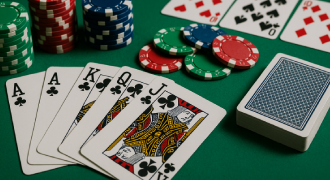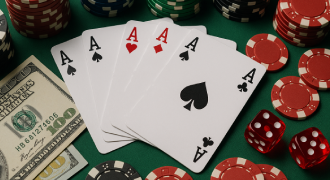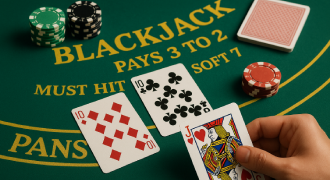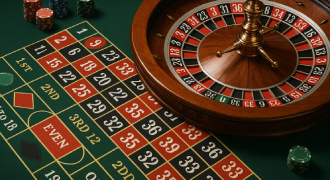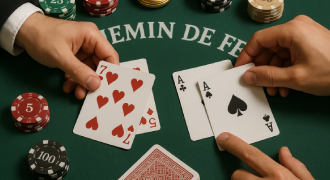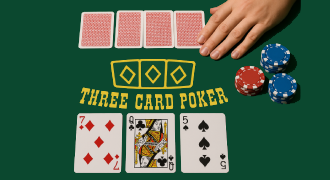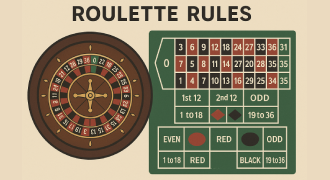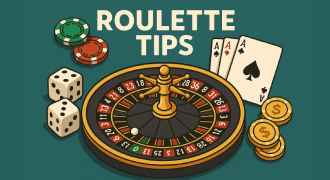Baccarat Chemin de Fer – The Classic European Baccarat
We invite you to step into our salon and try a tradition that has charmed for generations. Baccarat Chemin de Fer is the refined, communal cousin of modern house-dealt baccarat, where players take turns acting as the banker and decisions at the table shape the outcome. In this guide, our casino explains how the game works, what sets it apart, and why its rhythm still attracts connoisseurs who appreciate pace, etiquette, and table camaraderie.
Unlike the fast, automated versions you may know, this classic format rewards patience and understanding of procedure. You will learn the table layout, the draw rules, and the small but meaningful choices players make. By the end, you’ll know whether this card game belongs on your must-try list and how to approach your first session with confidence.
What Is Chemin de Fer and How It Differs from Punto Banco
Chemin de Fer is a player-banked variant of baccarat. In Punto Banco, the casino deals and settles every coup strictly by the rule book. In Chemin de Fer, the shoe rotates around the table and the active banker risks their own stake against the field. This creates a social dynamic in which etiquette and tempo matter as much as the cards. Think of it as a hosted dinner versus a buffet: both are satisfying, but the experience is different.
You will often see the debate framed as Chemin de Fer vs Baccarat or Baccarat vs Chemin de Fer. In practice, “Baccarat” in many rooms means Punto Banco—house-banked, with no player decisions beyond choosing a side. Chemin de Fer preserves an older rhythm: players may refuse a third card as banker in specific totals, and the largest counter-bet often determines who challenges the bank. The underlying arithmetic—aim for a total closest to nine—remains the same.
To make the distinctions clear at a glance, here is a quick comparison prepared by our pit team:
|
Aspect |
Chemin de Fer |
Punto Banco |
|
Bank |
Rotates among players |
Always the casino |
|
Dealing |
Player dealing from the shoe |
Dealer only |
|
Decisions |
Banker may stand/draw on certain totals |
Fully automatic by table rules |
|
Pace |
Deliberate, conversational |
Faster, continuous |
|
Social dynamic |
Players challenge the bank |
Players vs house only |
History of Chemin de Fer
The name likely references the “iron road,” the French nickname for early railways—fast and modern in their time. Baccarat chemin-de-fer emerged in French clubs where private banks and formal etiquette defined the evening. Over decades, it became the stylish option for players who preferred a hosted experience with rituals: passing the shoe, announcing stakes, and revealing card edges with ceremony.
As baccarat spread, casinos adopted house-banked formats to standardize procedures and speed up play. Yet the Chemin de Fer card game retained prestige in select salons, especially where privacy and tradition mattered. In those settings, the atmosphere—soft voices, crisp chips, and a measured deal—was as important as the mathematics of the game.
Table Setup and Player Roles
Our Chemin de Fer table is oval, with spaces for up to 9–12 participants depending on the room. A croupier supervises the game, tracks commission where applicable, and manages etiquette. Two dealers may assist with chips, calls, and recording outcomes, while the shoe sits before the current banker. The layout features two primary betting boxes—Banker and Player—and sometimes a third for ties, clearly marked for ease of use.
Because the bank rotates, seating order matters. The shoe passes clockwise after each coup unless the banker continues by winning and choosing to keep the bank. When you sit, our staff will brief you on your position, available stakes, and the calling conventions used at your table. Baccarat Chemin de Fer thrives on smooth cooperation between croupier and players, so our team maintains a calm, consistent cadence.
Roles at a glance
|
Role |
Who |
Responsibility |
|
Croupier |
House staff |
Oversees procedure, calls totals, ensures rules are followed |
|
Banker |
A seated player |
Sets the bank stake, deals from the shoe, decides draw/stand where allowed |
|
Punter(s) |
The other players |
Place wagers against the bank, receive/return cards via the croupier |
|
Dealers (assistants) |
House staff |
Handle chips, confirm payouts, maintain order |
Players taking turns as the banker
The right to bank moves clockwise. When the shoe arrives, you may accept or decline. If you accept, you announce your bank—how much you’re willing to risk this coup. Opponents may “go bank” by matching the full amount, or several punters can combine to meet it. This rotation is central to Chemin de Fer Baccarat, creating that signature blend of courtesy and competition.
If the banker wins, they may keep the bank for the next coup or pass the shoe along. Some seasoned guests choose to hold the bank through a streak, while others prefer to rotate to keep the game communal. Our staff will guide newcomers so the flow remains fair, friendly, and efficient.
Betting and dealing procedures
Bets open after the bank is declared. The largest opposing stake, or a single “go bank” call, typically determines who receives the Player hand. Cards are dealt face-down—two to Player, two to Banker—then totals are counted modulo 10. This is where newcomers often ask how to play Baccarat Chemin de Fer in practice: you add the digits of your hand and take only the last digit (e.g., 7+8=15 becomes 5).
The croupier announces totals, manages any third-card draws under the table rules, and then declares the result. Payouts follow immediately. Etiquette matters: players keep cards low, avoid exposing card edges prematurely, and let the croupier handle the announcements so the rhythm stays intact.
Key Rules and Game Flow
To orient new guests, we summarize the Baccarat Chemin de Fer rules you will encounter. A “coup” starts when the banker sets a stake and ends when the croupier calls the result. Natural 8s and 9s stand immediately; otherwise, a third card may be drawn to one or both hands according to established rules. The banker has limited discretion (described below) that distinguishes this format from house-dealt versions.
Coup at a glance
|
Step |
Action |
|
1 |
Banker declares the bank stake; punters place wagers. |
|
2 |
Two cards to Player, two to Banker (face-down). |
|
3 |
Croupier announces totals; naturals (8/9) stand and settle. |
|
4 |
If no natural, Player may receive a third card per drawing table. |
|
5 |
Banker may draw or stand, partly informed by Player’s third card. |
|
6 |
Result announced; winning side paid even money (house commission may apply to Bank wins per local practice). |
While many houses print a full “third-card table,” newcomers can remember a few anchors:
- Player draws on totals 0–5 and stands on 6–7 (naturals 8–9 stand).
- Banker rules are conditional: if Player stands, Banker draws on 0–5 and stands on 6–7; if Player draws a third card, the Banker’s decision follows a matrix referencing that card’s value.
- Ties push; some rooms offer a tie wager with enhanced odds, though we encourage learning the main bets first.
For transparency, our floor team keeps a reference sheet of Chemin de Fer rules at the table. Ask to review it at any time; our staff will happily walk you through a sample coup so you can practice totals before you play.
Strategic Elements of Playing Chemin de Fer
Chemin de Fer is often described as a game of ritual rather than deep strategy, but there is still room for judgment. The key decision sits with the banker when totals and the Player’s third card place the hand at a threshold. Some veterans follow a conservative matrix that mirrors house-banked baccarat; others shade their choice based on table mood or recent patterns to keep opponents guessing.
Our advice is to learn the standard decision points first, then refine as you grow comfortable. Table management is equally important. Announce stakes clearly, respect the croupier’s calls, and keep the exchange focused—this isn’t about hot streak boasts; it’s about flow. The Chemin de Fer game rewards discipline: arrive with a session budget, choose a seat where you can observe procedures, and consider starting as a punter for a few coups before accepting the bank.
Finally, remember that speed is not the goal. Chemin invites conversation and careful dealing. If you prefer a faster pace with minimal decisions, our Punto Banco tables will suit you better. If you enjoy a collaborative game with heritage and poise, Chemin will feel like home.
Why Chemin de Fer Is Rare in Modern Casinos
Operationally, Chemin de Fer requires more staff and time per coup than house-banked baccarat. The rotation of the bank, the etiquette of passing the shoe, and the need for a croupier who can guide new players all slow throughput. Modern floors often favor faster formats that accommodate more hands per hour.
There’s also the matter of audience. Many guests discover baccarat on digital or live-stream tables and then seek the same pace on the floor. That reality has shifted demand away from Chemin. Even so, Baccarat and Chemin de Fer are complementary: one emphasizes speed and consistency; the other elevates ritual and social interplay. We keep a Chemin table open during peak evenings for guests who want that classic ambiance.
From a training perspective, Chemin demands dealers who understand historic conventions and can keep the game friendly for first-timers. We invest in that expertise because the experience is worth preserving, but that specialization is one reason you won’t see Chemin everywhere.
Should You Try Chemin de Fer?
If you appreciate tradition, teamwork at the table, and a deliberate tempo, yes—pull up a chair. Baccarat Chemin de Fer blends straightforward arithmetic with a theater of manners that you won’t find in faster formats. You’ll still aim for nines and celebrate naturals, but the journey to each result is more communal and more ceremonial.
New to the format? Start as a punter, watch a few coups, and ask our team to review a sample draw. When the shoe reaches you, take the bank for a single hand to feel the role. Win or lose, you will understand why devotees return for the atmosphere as much as the outcomes.
When you’re ready, our salon staff will seat you, brief you on limits, and provide a quick refresher on totals and draws. Baccarat Chemin de Fer remains one of the most memorable table experiences we offer, and we’re proud to host it for guests who value authenticity.
FAQ
What makes Chemin de Fer unique?
Chemin’s signature is the rotating bank and the banker’s limited decision on whether to draw or stand in certain totals. This creates a conversational rhythm and lets players shape the flow.
Can I play Chemin de Fer online?
Pure Chemin is rare online because the model depends on a rotating player bank and face-down handling. Some live studios offer hybrids that capture the look and cadence, but the full ritual thrives in a physical room with a croupier.
How are banker and player roles assigned?
The shoe moves clockwise. When it arrives, you can accept or decline the bank. The banker announces a stake; a single opponent may “go bank” by covering it fully, or multiple punters can combine to meet it.
Is this game more skill-based than Punto Banco?
There is a bit more judgment because the banker can choose to draw or stand in specific situations, particularly after seeing the Player’s third card. That said, outcomes still follow strict rules, and no system can overcome the math of the shoe.
Is it worth learning Chemin de Fer today?
If you enjoy classic table culture, absolutely. The format offers a social, elegant alternative to rapid-fire sessions. You’ll pick up the essentials quickly, and the etiquette becomes second nature after a few coups.

